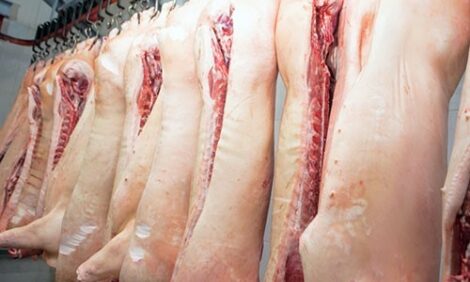



Phase I of pelvic organ prolapse study offers new insights
A pelvic organ prolapse (POP) is a dramatic, easy-to-identify event within the farrowing room.The difficult part is figuring out the cause and applying a solution. Pork producers and veterinarians have been struggling to address the upward trend in POPs for the past 10 to 15 years. But it was a jump in cases since 2013/2014 that raised the urgency to a new level.
“The incidence doubled over the last five years and nobody knows why,” Chris Rademacher, DVM, Iowa State University (ISU), told Pig Health Today. “We haven’t been able to pin it down to one specific thing.”
As a result, producers and veterinarians asked the National Pork Board to commit Pork Checkoff dollars to fund an in-depth, multi-year study. The initial project was awarded to the Iowa Pork Industry Center (IPIC) at ISU, which began in 2017 and now involves a team of researchers.
Enrolling and surveying farms
To ensure a common understanding, a POP was defined to include a vaginal prolapse, a full uterine prolapse, a rectal prolapse or it could be some combination of those.
For the data collection, IPIC researchers enrolled 104 sow farms located across the US. Of those, 85 were from 13 large production systems, and 19 were independent producers. In all, 400,000 sows were enrolled, representing roughly 8 percent of the swine industry.
On each of the farms, caretakers recorded every sow death, regardless of the reason, on a standardized form and sent it to IPIC every week. This took place over six months.
Another part of the project involved a survey to gain more perspective of the farm composition and management. Rademacher shared some sample questions: What are your farrowing room protocols? What are your facilities like? Do you pulse antibiotics? What is your diet and feeding regimen? What is your water source?
A third step involved sending personnel out to about 60% of the farms to take various body measurements on a subset of sows just before and after farrowing. Notably, 80% to 90% of POPs occur right before or right after farrowing.
What they’ve found so far
“The first goal was to try to identify three to five researchable hypotheses that we could study in more depth,” Rademacher noted.
There certainly has been no shortage of in-the-field anecdotes and working hypotheses for POPs, but the IPIC study both confirmed some expectations and provided surprises.
For example, big farms, big sows and big litters were all suspected to contribute to higher incidence of POPs. However, “we didn’t see any correlation at all,” Rademacher noted, “which is good, because we can get rid of those.” The same was true for sleeving sows or inducing farrowing.
Some of the trends that researchers did uncover and plan to investigate further include:
- Seasonal: POP rates increase going into and coming out of the winter months, but that varied between farms. Researchers grouped farms according to their POP rates - 20 percent high, 60 percent medium and 20 percent low. They looked at the weekly results and found that farms with low- and medium-POP rates remained consistent throughout the year. It was the high-POP farms that struggled with seasonal increases.
- Water: The study compared water sources and whether the farm used some sort of water-sanitation system. What they found was that, regardless of the source, farms with treated water had much lower POP rates than non-treated farms.
- Sow body condition: Inverse to common thinking, it is the thin sow that’s more likely to prolapse. Also, farms that stepped-up feeding for thin sows in late gestation tended to have lower POP rates. “So, there may be a nutritional body-condition component to it,” Rademacher noted.
- Pulsed antibiotics: Farms that pulsed antibiotics saw a temporary decrease of POPs during the pulsing period. Once off the routine, the POP rates would go back to their baseline rates. “We’re trying to understand if there’s a sanitation, hygiene or population of bacteria that influences POP on some farms,” he said.
- Housing type: This addressed gestation-sow housing - pen/group and traditional stalls. “We did tend to see a higher probability [of POPs] for those housed in pens than in stalls,” Rademacher noted. However, the two housing types were not equally represented. “We also looked at overall sow mortality, since we were collecting that data, and saw the same trend.”
- Parity: The study looked at parity, but because researchers relied on the farm’s production records, it’s not a definitive conclusion. It showed a slight increased risk as sows got older, but “it wasn’t strong epidemiological evidence,” Rademacher said. “We certainly see it [POPs] across all parities.”
- Genetics: In the field, genetics often comes into question as a POP trigger. While the study did show some differences, Rademacher emphasized that because genetics were not statistically sorted or represented, the study is not able to determine correlations. “But perhaps we could look for a genetic marker someday,” he added.
Future ideas and direction
Because of the jump in POP rates following the 2013 introduction of porcine epidemic diarrhea virus (PEDV) to the US herd, the researchers considered herd health and disease profiles. Specifically, they looked at PEDV and porcine reproductive and respiratory syndrome impact since about 50 percent of the herds reported cases. In the end, there wasn’t a distinct trend, so it’s unlikely to generate more investigation, Rademacher said.
They are going to dig deeper into the water quality and sanitation discovery. Also, they’re planning to study the vaginal microbiome - specifically, looking at different types of compounds and bacteria that may be impacting the sow, and whether hygiene practices are helping or hindering mitigation efforts.
So, research into POPs is continuing and hopefully answers will follow in the years ahead. Rademacher and others, including the participating farms, are hopeful. “The great part is the collaboration,” he added. The 13 systems and 19 independent producers did a lot of extra work, filling out forms and sending in data, without getting anything in return - yet.








